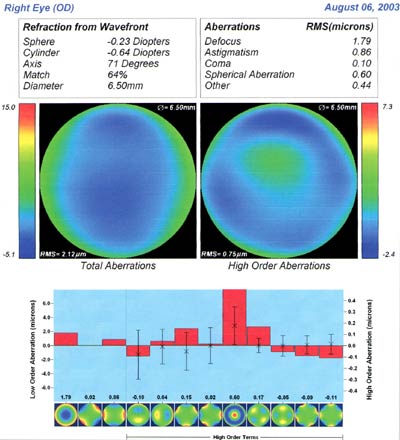Wavefront enhancement after LASIK
This month, a 50-year-old male TV news anchor presents for a customized enhancement 2 years after conventional LASIK.
![]()
History: Patient is a 50-year-old male TV news anchor who had LASIK surgery for myopic astigmatism correction in both eyes 2 years ago. He complained of reduced quality of vision in his right eye with halos and glare at night and a slight shadow image. The patient was found to be a good candidate for an off-label wavefront-guided CustomCornea ablation.
System: Alcon LADARVision CustomCornea Platform
Preoperative examination right eye:
Uncorrected visual acuity: 20/25 (with shadows)
Manifest refraction: –0.5 –0.5 3 22
Best-corrected visual acuity: 20/20 (with shadows)
Preoperative wavefront map (Figure 1): Higher-order aberrations: Coma: 0.6 µm; spherical aberration: 1.17 µm; other terms: 0.38 µm
Procedure: CustomCornea LASIK enhancement on May 15, 2003.
Before surgery, the maximum depth of ablation was predetermined to be 52.8 µm for a wavefront refraction of –0.59 –0.34 3 54º due to the high spherical aberration. In order to avoid the potential for overcorrection, a +0.5 D offset was used, and copious irrigation of the stromal bed with balanced salt solution was performed after lifting the original flap, with moist sponge removal of the surface layer of fluid before ablation. The procedure was performed live on the evening news.
3-month postoperative examination right eye:
Uncorrected visual acuity: 20/20
Manifest refraction: plano –0.5 3 65
Postoperative wavefront map (Figure 2): Higher-order aberrations: Coma: 0.1 µm (reduced by 83%); spherical aberration: 0.6 µm (reduced by 49%)
Conclusion: The patient’s operative outcome using the off-label Alcon CustomCornea treatment was good, with 20/20 vision and no double image or halos. By examining the wavefront maps, we can see the reduction of low-order aberration (defocus) and higher-order aberrations (coma and spherical aberration). We know that especially in scotopic conditions, coma is correlated to double vision, and spherical aberrations and total higher-order aberrations are correlated to glare. By decreasing these higher-order aberrations, we decreased the patient’s ocular symptoms, and he was happy with his surgery’s outcome. The surgical steps of using a +0.5 D offset (0.5 D less treatment) and irrigation of saline onto the stromal surface are necessary when performing a re-treatment in the presence of a high amount of spherical aberration and relatively high maximum depth of ablation. Drying of the stromal surface during a high spherical aberration re-treatment is offset by both these steps to effectively avoid overcorrections when a minimal refractive error is present.
|
(Images courtesy of Maria Regina Chalita, MD, and Ronald R. Krueger, MD, MSE.) |


